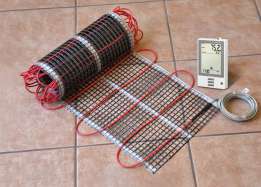
What It Is:
An efficient home heating system that turns entire floors into radiators, warming living spaces without uncomfortable hot or cold air pockets.
How It Works:
Hot water is pumped from a boiler through a loop of flexible tubing embedded in the floor.
Why You’d Want One:
Eliminates forever the discomfort of cold floors as it slashes energy bills.
What To Look For:
Multiple heating zones: Makes it easy to fine-tune the amount of heat being delivered to different rooms.
Outdoor Reset Control:
Slowly raises and lowers the amount of hot water flowing through the tubing in response to changing outside temperatures.
Pex Tubing:
Specially treated polyethylene carries the hot water for hydronic systems. Unlike copper, this inert plastic won’t corrode and can be installed in long runs with just a couple of fittings, reducing the chance of leaks.
What It Costs:
$6 to $15 a square foot for installation. In general, expect to pay 50 percent more for a hydronic radiant flooring system than for conventional forced-air heat.
Where To Get It:
No one manufacturer supplies all the components for hydronic radiant heating. You’ll need a good heating contractor to put a system together. With electric radiant, it’s easy to find turnkey systems.
Radiant Foors From the Romans to Wright
Radiant heat dates to ancient times, when the Romans warmed rooms by running the flues for slave-tended, wood-burning fires under elevated marble floors, keeping toes and togas nice and toasty.
Many centuries later, in this country, Frank Lloyd Wright buried copper pipes in the concrete floors of his Usonian homes and warmed them with hot water. A few postwar subdivisions, including Levittown, followed suit. But when the pipes eventually corroded, most homeowners abandoned radiant rather than jackhammer their floors.
Today, plastic PEX tubing has replaced metal as the favored means of feeding hydronic heat into floors, making radiant more affordable than ever. And with a no-fail track record in Europe going back more than 35 years, it’s also made them more reliable.
Radiant heating looped electric wire
The Floor Electric: For an alternative to the cost and complication of a hydronic system, there’s electric radiant heat. Its warmth comes from a loop of thin electric wire laid directly under the finish floor. No boiler, no water, no 1/2-inch-thick tubing to alter the floor’s height. You’ll need an electrician to connect the wiring to the panel, but the rest of the installation is no more difficult than laying tile. The catch lurks in your utility bill: the 6 to 10 watts per square foot the system uses per hour makes it prohibitively expensive to heat a whole house. It’s best for spot heating, such as taking the chill off a tiled bathroom or stone countertop.
